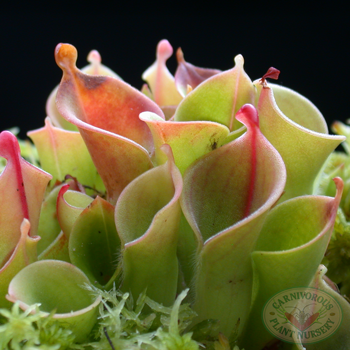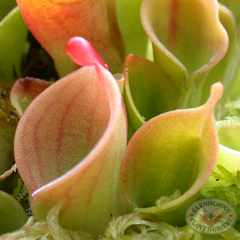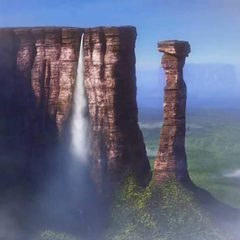
Heliamphora
Sun Pitchers
Heliamphora are collectively known as Sun Pitchers, based on the mistaken notion that "helio" from the name is based on the Greek word for "sun". But it is actually derived from "helia" the greek work for "marsh." Currently there are 24 species recognized and dozens of man-made hybrids. None of them have common names in English.
They are native to the Tepuis of the Guiana Highlands which are high sandstone mesas in Venezuela, Guyana and Brazil. They appear lost in the clouds at 6,000 to 10,000 feet (1800-3000m), and have been highlighted in several "Lost World" stories. They host an isolated and ancient ecology.
They were first encountered by Europeans in 1838 by German geographer Robert Schomburg. It was brought into horticulture by the Veitch Nurseries of Belgium in 1889, and attracted much attention in their first illustrations to appear in The Gardeners' Chronicle. The tepuis and their flora remained obscure and unaccessible for many years. Only in the last 40 years have their diversity of species been known.
Heliamphora are clump-forming perennials forming a rosette of vertically cylindrical leaves. The roots are branching and brittle.
The nodding flowers are borne on tall scapes. They are bell-shaped, and typically bright white and pink with some red. They do not produce nectar, and do not have a scent. They are insect pollinated and do not self pollinate naturally. The buzzing vibration of the beating wings of large bees and bumblebees trigger a spurt of pollen from the flower, spraying the insect with pollen to be delivered to the next visited flower. This can be mimicked with a tuning fork and small brush in cultivated plants.
Heliamphora readily hybridize. Cross pollination frequently produces an abundance of seeds, compared to species pollination.
Heliamphora produce two types of leaves. Juveniles trap(ages 1-3+) are simple, tubular and typically short. The tips roll back on themselves and have a small narrow prey opening. They are typically red, pink or orange in color, and are very similar among the different species. Adult traps (ages 3-5+) though larger than juveniles, are short cups or tubes with slightly swollen middles. A slit on the front helps the trap maintain a consistent water level. Traps are tipped with a mini hood or cup-like nectar spoon, that exudes a sweet liquid, which draws lots of insect attention. Traps frequently have a sweet scent. The inner portions of adult traps show zones of differentiation similar to sarracenia, including downward pointing hairs, and a digestive zone.
Heliamphora typically grow in three general habitats, that form a continuum down the steep tepuis. They are: the summits, the cloud forest flanks and the boggy foothills. The summits are some of the wettest places on Earth with annual rainfall over 350" (890cm). Such a great deal of intense rain creates a "rain desert" by scouring any soil away, often leaving bare bedrock in most places and scant remains of nutrient-poor gravels and soil in gullies and channels. The cool and ultra-humid summits show a distinct diural (day/night) cycle. Day temperatures peak between 60-75°F (15-21°C) and drop to 45-55°F (7-13°C) at night. This is consistent throughout the year. Freezing never occurs. Low areas are poorly drained, and form mini-marshes scattered across the terrain where Heliamphora fluorish because of their carnivorous habit. A mix of heliamphora grow opportunistically on the tepuis cliff faces. The open boggy foothills, below the tepuis and often near or resulting from the waterfalls, produce good heliamphora habitat. Here diurnal temperatures range from 72-80°F (22-27°C) in the daytime to 45-60°F (7-15°C) at night. Water is even more abundant than on the summits. Heavy nighttime dew often blankets the habitat. Lowland habitat occurs in poorly drained seepage areas that are permanently saturated. It is hotter and less humid than the plateau summits. Here the daily temperatures fluctuate between 78-80°F (25-27°C) in the daytime, and 55-65°F (12-18°C) at night. Rainfall is considerably less at about 24"(60cm) annually. Here, Heliamphora often are seen growing in and among the carnivorous bromeliads. Brocchinia hechtioides and B. reducta.
Heliamphora grow slowly, and at steady rates all year long, and do not require dormancy. Their rhizomes have a tendency to divide and frequently form clumps of plants.




